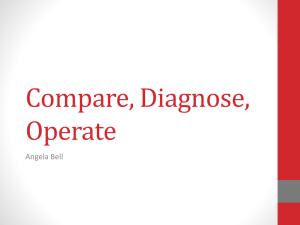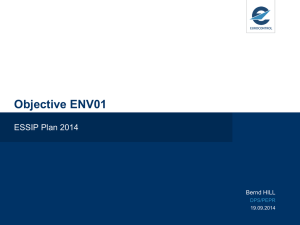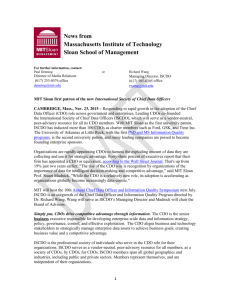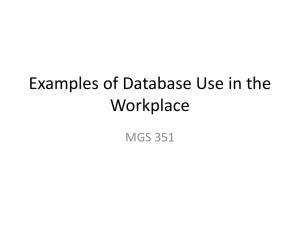Chapter 22 - Richard (Rick) Watson
advertisement
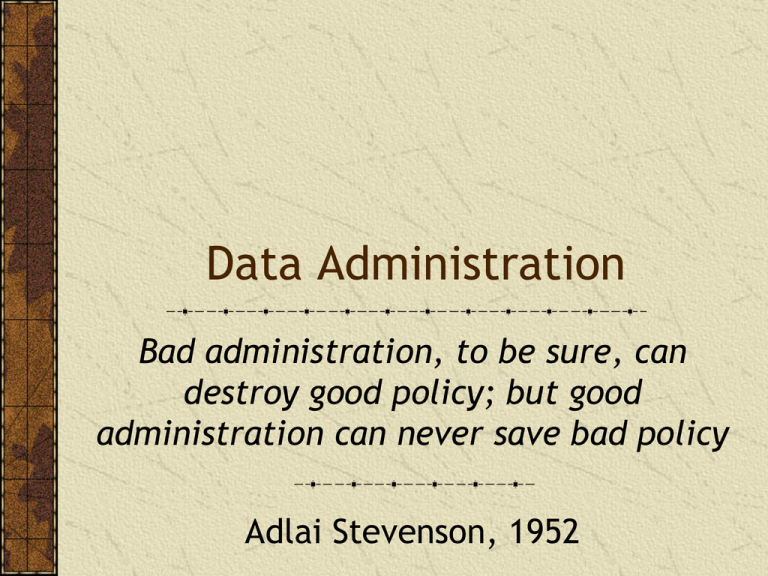
Data Administration Bad administration, to be sure, can destroy good policy; but good administration can never save bad policy Adlai Stevenson, 1952 Data administration Data are the lifeblood of organizations Data need to be managed Data administration is concerned with the management of organizational memories 2 Data are generated by stakeholders Employees Customers Shareholders Investors Suppliers Government 3 Data management problems Redundancy Inconsistent representations Multiple definitions of data items Essential data missing Inaccurate or incomplete data Uncaptured data Data that cannot be located 4 Goals of data management Enable clients and customers to access the data they need in the most suitable format Maintain data integrity 5 Chief Data Officer (CDO) A new C-level position Responsible for the strategic management of data systems and ensuring that the organization fully seizes data-driven opportunities In 2003, Capital One was perhaps to first firm to appoint a CDO 6 CDO role dimensions Collaboration direction Inward or outward Data management focus Traditional transaction or big data Value orientation Service or strategy 7 Three dimensions of the CDO Strategy Traditional data Outward Inward Big data Service 8 Inward collaboration Initiatives might include developing data quality assessment methods, establishing data products standards, creating procedures for managing metadata, and establishing data governance The goal is to ensure consistent data delivery and quality inside the organization 9 Outward collaboration An outwardly-focused CDO will strive to cooperate with an organization’s external stakeholders One CDO led a program for “global unique product identification” to improve collaboration with external global partners Another might pay attention to improving the quality of data supplied to external partners 10 Traditional data management Traditional data are still the foundation of many organization’s operations There remains in many firms a need for a CDO with a transactional data orientation Traditional data are typically managed with a relational databases 11 Big data management Big data promises opportunities for improving operations or developing new business strategies based on analyses and insights not available from traditional data A CDO attending to big data can provide leadership in helping a business gain deeper knowledge of its key stakeholders 12 Service orientation If the top management team is mainly concerned with oversight and accountability, then the CDO should pay attention to improving existing datarelated processes 13 Strategy orientation If the senior team actively seeks new data-driven strategic value, then the CDO needs to be similarly aligned and might look at how to exploit digit data streams One strategy-directed CDO, led an initiative to identify new information products for advancing the firm’s position in the financial industry 14 CDO archetypes Inward Coordinator Reporter Architect Ambassador Analyst Marketer Developer Experimenter Outward Traditional data Big data Strategy Service CDO archetypes Archetype Definition Coordinator Fosters internal collaboration using transactional data to support business services Reporter Provides high quality enterprise data delivery services for external reporting Architect Designs databases and internal business processes to create new opportunities for the organization Ambassador Develops internal data policies to support business strategy and external collaboration using traditional data sources Analyst Improves internal business performance by exploiting big data to provide new services Marketer Develops relationships with external data partners and stakeholders to improve externally provided data services using big data Developer Navigates and negotiates with internal enterprise divisions in order to create new services by exploiting big data Engages with external parties, such as suppliers and industry peers, to Experimenter explore new, unidentified markets and products based on insights derived from big data Management of the database environment 17 Components of the database environment Databases User interface Data dictionary External databases 18 Data administration System Environment wide management issues Planning Data standards and policy Data integrity Resolving data conflicts Managing the DBMS Data dictionary Benchmarking Project Defining user requirements Data modeling Training and consulting Monitoring integrity and usage Change management 19 Data administration vs. database administration Not an appropriate distinction System Data administration Project Database administration Think in terms of system and project rather than data and database Data administration can refer to both system and project level functions 20 Data administration functions and roles A function is a set of activities to be performed Individuals are assigned roles to perform certain activities Data administration functions may be performed by a: Data administrator Data administration staff Database development Database consultant Database analyst 21 Data steward Responsible for managing all corporate data for a critical business entity or product Cuts across functional boundaries Aligns data management with organizational goals 22 Database use levels Personal Workgroup Organizational More users means greater complexity 23 Personal databases Notebook computers Personal digital assistants (PDAs) Personal information managers (PIMs) Cell phones Music players (iPod) Information appliances 24 Workgroup and organizational databases Shared by many people Greater complexity Require more planning and coordination than personal databases 25 System level data administration Planning Development of data standards and policies Data integrity Data conflict resolution Managing the DBMS Establishing and maintaining the Data Dictionary Selection of hardware and software Benchmarking Managing external databases Internal marketing 26 Selection of hardware and software How many users will simultaneously access the database? Will the database need to be geographically distributed? What is the maximum size of the database? How many transactions per second can the DBMS handle? What kind of support for on-line transaction processing is available? What are the initial and ongoing costs of using the product? What is the extent of training required, will it be provided, and what are the associated costs? 27 Project level data administration functions Meeting the needs of individual applications and users Support and development of a specific database system 28 Systems Development Life Cycle Application Development Life Cycle (ADLC) Database Development Life Cycle (DDLC) Project planning Project planning Requirements definition Requirements definition Application design Database design Application construction Application testing Database testing Application implementation Database implementation Operations Database usage Maintenance Database evolution 29 Strategies for system development Database and applications developed independently Applications developed for existing databases Database and application development proceed simultaneously 30 Development roles Database Development Phase Database Developer Data Administrator User Project planning Does Consults Provides information Requirements definition Does Consults Provides requirements Database design Does Consults Validates data models Data integrity Database testing System and user testing Consults Does user testing Database implementation System related activities Consults Database usage Consults Data integrity monitoring Uses Database evolution Does Change control Provides additional requirements Data integrity Does user activities Data integrity 31 Database development cycle Data administration interfaces 33 Data administration interfaces Management Sets the agenda and goals Users Seek satisfaction of goals Development Co-operation Computer operations Establishing and monitoring procedures for operating databases 34 Data administration tools Database development phase Data Dictionary (DD) Database Management System (DBMS) Performance monitoring Case tools 1. Project planning Document Data map Design aid Estimation tools 2. Requirements definition Document Design aid Document Design aid 3. Database design Document Design aid Data map Schema generator Document Design aid Data map 4.Database testing Data map Design aid Schema generator Define, create, test, data integrity Impact analysis 5.Database implementation Document Change control Data integrity Implement Design Monitor Tune 6. Database use Document Data map Schema generator Change control Provide tools for retrieval and update Enforce integrity controls and procedures Monitor Tune 7. Database evolution Document Data map Change control Redefine Impact analysis Test data generator Design aid 35 Use of the data dictionary Documentation support Data maps Design aid Schema generation Change control 36 Data integration Lack of data integration is a common problem Examples Different identifiers for the same instance of an entity The same data stored in multiple systems Related data stored in different databases Different methods of calculation for the same business indicator in different systems 37 Data integration Red division Blue division partnumber (code for green widget) 27 27 customerid (code for UPS) 53 53 Definition of salesdate The date the The date the customer signs customer signs the order the order 38 Lack of data integration Red division Blue division partnumber (code for green widget) 27 10056 customerid (code for UPS) 53 613 The date the customer signs the order The date the customer receives the order Definition of salesdate 39 Goals of data integration A standard meaning and format for all data elements A standard format for each and every data element A standard coding system A standard measurement system A single corporate data model for each major business entity 40 Data integration strategies Environmental High turbulence Low Moderate Moderate High Low Low High Unit interdependence 41 Organizing the data administration function Creation of the function Selecting staff and assigning roles Locating the function 42 Conclusion Data administration is Critical to the success of most organizations Necessary for data-driven decision making Growing in complexity Increasingly requires the appointment of a CDO to ensure appropriate strategic attention 43


